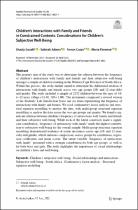| dc.contributor.author | Florence, Maria | |
| dc.contributor.author | Savahl, Shazly | |
| dc.contributor.author | Adams, Sabirah | |
| dc.date.accessioned | 2022-06-30T06:45:52Z | |
| dc.date.available | 2022-06-30T06:45:52Z | |
| dc.date.issued | 2021 | |
| dc.identifier.citation | Savahl, S., Adams, S., Casas, F. et al. Children’s Interactions with Family and Friends in Constrained Contexts: Considerations for Children’s Subjective Well-Being. Applied Research Quality Life (2022). https://doi.org/10.1007/s11482-022-10059-7 | en_US |
| dc.identifier.uri | https://doi.org/10.1007/s11482-022-10059-7 | |
| dc.identifier.uri | http://hdl.handle.net/10566/7538 | |
| dc.description.abstract | The primary aim of the study was to determine the relation between the frequency of children’s interactions with family and friends and their subjective well-being amongst a sample of children residing in the Western Cape Province of South Africa. Within this process, the study further aimed to determine the differential relation of interactions with family and friends across two age groups (10- and 12-year-olds) and gender. The study included a sample of 2252 children between the ages of 10-to 12-years (Mage = 11.01, SD = 1.00). The instrument comprised a revised version of the Students’ Life Satisfaction Scale and six items representing the frequency of interactions with family and friends. We used confirmatory factor analysis and structural equation modelling to analyse the data, with multi-group structural equation modelling to analyse the data across the two age groups and gender. We found a significant relation between children’s frequency of interactions with family and friends and their subjective well-being. While each of the latent constructs made a significant contribution, ‘frequency of interactions with family’ made the highest contribution to subjective well-being for the overall sample. Multi-group structural equation modelling demonstrated evidence of scalar invariance across age (10- and 12-yearolds) and gender, which endorses comparisons across groups by correlations, regression coefficients and mean scores. The latent variable ‘frequency of interactions with family’ presented with a stronger contribution for both age groups, as well as for both boys and girls. The study highlights the importance of social relationships on children’s lives and well-being. | en_US |
| dc.language.iso | en_US | en_US |
| dc.publisher | Springer Nature | en_US |
| dc.subject | Children’s subjective well-being | en_US |
| dc.subject | Social relationships and interactions | en_US |
| dc.subject | Subjective well-being | en_US |
| dc.subject | South Africa | en_US |
| dc.subject | Confirmatory factor analysis | en_US |
| dc.subject | Structural equation modelling | en_US |
| dc.title | Children’s interactions with family and friends in constrained contexts: Considerations for children’s subjective well‑being | en_US |
| dc.type | Article | en_US |

